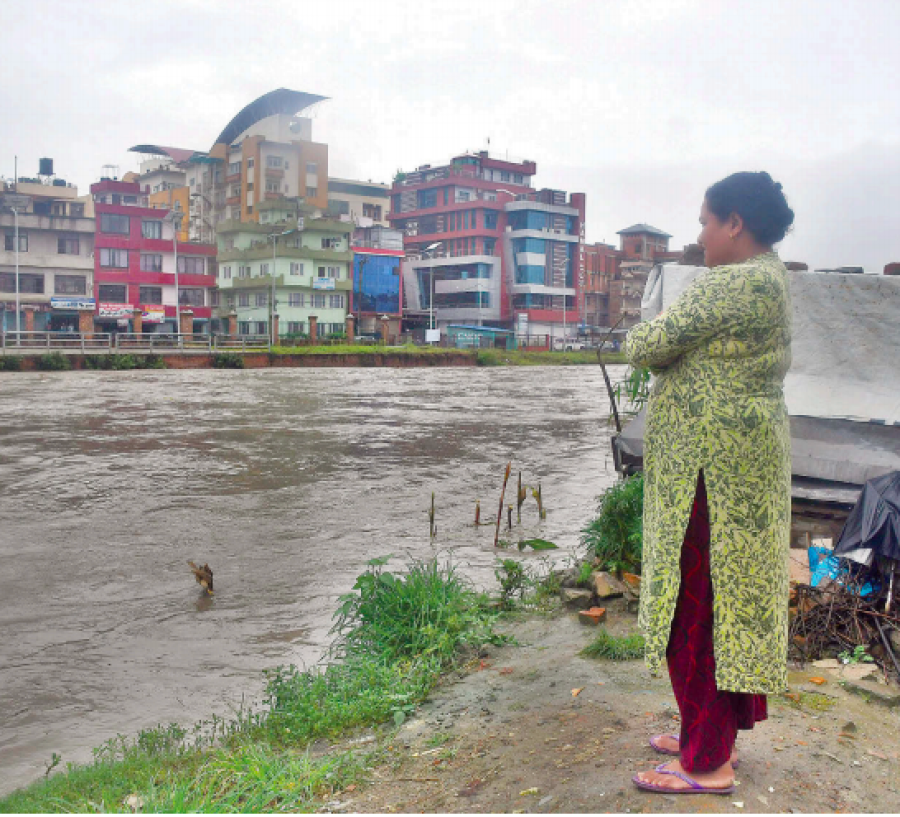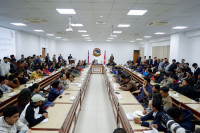National
Rain-swollen Bagmati threatens squatter settlement in Thapathali
First it was the coronavirus lockdown and now it is the fear of flood and water-borne diseases that haunt these poor families.
Anup Ojha
Till late Monday afternoon, the rain was incessant in Kathmandu Valley.
Chitra Bahadur Pulami Magar’s four-member family, living in a squatter settlement in Thapathali on the banks of the Bagmati river for over 15 years, was stuck in their hut in fear of flood waters entering their settlement.
By late afternoon waters from the swelling river started gushing into their hut and other half a dozen shacks nearby.
“We woke up three times Sunday night to look at the water level in the river,” said Magar, 63, a mason by profession.
He and his son Prakash, 38, also a daily wage worker, have been in severe economic strain since the March 24 nationwide lockdown. Prakash began working only last week while his father is still looking for work.
Even the weather has turned against them this year. The river did not swell so much as to enter their settlement in the past. This year, however, the river spilled over its banks and entered the homes of landless squatters in Thapathali.
Their problem is not over yet, as the Meteorological Forecast Division has predicted the likelihood of heavy rains in the Bagmati Province till Wednesday.
“The three month’s lockdown was a nightmare for us. We hardly survived it,” said the Magar. “The fear of transmission of the coronavirus is ever present. Now we are living in fear of this river.”
It’s not only the Magar family, but hundreds of squatters living on the river banks whose huts may be washed away by Bagmati. They are living in constant fear of flood. Fear also of water-borne diseases.
“Every one of us is living here with fear. We have nowhere else to go,” said Chandra Tamang, chairperson of the Oppressed Squatter Committee fighting for squatter issues at Thapathali and elsewhere in Kathmandu Valley. “Mosquitoes are everywhere, and if we suffer from malaria and dengue we can’t go to the hospital in the current situation of pandemic.”
Virologist Dr Sher Bahadur Pun at the Sukraraj Tropical and Infectious Disease Hospital in Teku says squatter settlements are prone to scrub typhus causing fever, headache, body aches, and sometimes rashes, malaria and dengue.
“These many also have flu-like symptoms, and they could mistake it for Covid-19,” Pun added.
The Thapathali area has 156 households with over a thousand members.
Sita Gurung, 40, mother of three daughters and two sons, has been living in the settlement for over a decade. She was worried about spending nights in her hut.
“The river is too close. Water has started to enter our huts, and it feels that death is looming over us,” said Gurung.
Throughout Monday, one could see the fear and worry on the faces of the residents living in the Thapathali squatter shanty. Many of them were staring helplessly at the rain-swollen Bagmati.
“It’s only God who can save us from this flooding now,” said Gurung.
According to the Nepal Landless Democratic Union Party, there are more than 29,000 landless people in Kathmandu Valley living in 73 settlements. Of them, 1,082 families were registered as squatters in 2012. The union’s report shows over 8,000 families are living along the Bagmati riverbanks alone.
Eighty percent of the total squatter population lives on riverbanks while others have occupied public land in Kathmandu, Bhaktapur and Lalitpur, according to the report.
Meanwhile, some settlements in the Teku area were also inundated by flood waters on Monday. Police said there were no casualties.
Landless squatters living along riverbanks is a perennial problem in Kathmandu.
Although successive governments have talked about solving squatters' problems, there has not been any significant step.
When the Post reached out to Janak Raj Joshi, joint secretary at the Ministry of Land Management, Cooperatives and Poverty Alleviation, he said that the government has formed a commission to resolve various land related problems, including that of landless squatters.
Uttar Kumar Regmi, chief at the Disaster Management Department at the Kathmandu Metropolitan City, said the city office is concerned about the issue but it cannot do not anything about it.
“I am going to consult with the High-powered Bagmati Civilization Integrated Development and Kathmandu Valley Development Authority on Tuesday and take necessary steps to address the problem faced by the squatters living near Bagmati,” said Regmi.
In 2012, the Baburam Bhattarai government had mobilised more than 2,000 security personnel to demolish 251 huts of landless squatters in Thapathali.
Among the families who were rendered homeless, only 46 families received Rs 25,000 to relocate elsewhere while 11 families were resettled near Manohara River, where they still face flood risk every monsoon.
The other families eventually returned to Thapathali to rebuild their settlement. Over the years, the riverside settlement has grown larger.




 16.12°C Kathmandu
16.12°C Kathmandu.jpg)















